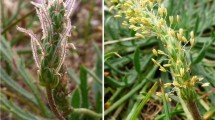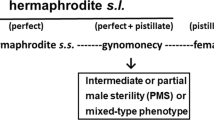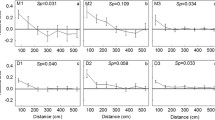Summary
Cytoplasmic male steriles occur regularly in wild populations of the annual crucifer Hirschfeldia incana Lagr.-Foss. in Israel. In these plants numbers of ovules per flower, numbers of seed per fruit, and total seed weights per plant are slightly higher than in the hermaphrodites with which they mate. Yet their frequencies in wild populations do not exceed 2–10 per cent. There are no signs of incipient dioecy. The species is self incompatible and no mechanisms to enforce outcrossing are needed. It is argued that in this and similar cases gynodioecy functions as a pollen saving measure. Precise pollen presentation in the flower renders some of the pollen redundant and facilitates its abolition in a sector of the population. It is possible that the enhanced seed fecundity of the pollenless sector stems from a greater availability of plant resources for seed production in the unisexual than in the bisexual seed parent.
Similar content being viewed by others
Literature
Arroyo, K.M.T.; Raven, P.H. (1975): The evolution of subdioecy in morphologically gynodioecious species of Fuchsia sect. Encliandra (Onagraceae). Evolution 29, 500–511
Assouad, W.B.; Dommée, B.; Loumaret, R.; Valdeyron, G. (1978): Reproductive capacities in the sexual forms in the gynodioecious species Thymus vulgaris L. Bot. J. Linnean Soc. 77, 29–30
Brewbaker, J.L.; Kwack, B.H. (1963): The essential role of calcium ion in pollen germination and pollen tube growth. Amer. J. Bot. 50, 859–865
Burrows, C.J. (1960): Studies in Pimelea. 1: The breeding system. Transact. Roy. Soc. New Zeal. 88, 29–45
Burtt, B.L. (1978): Notes on the evolution of Compositae: Compositae Newsl. 7, 6–7
Charlesworth, B.; Charlesworth, D. (1978): A model for the evolution of dioecy and gynodioecy. Am. Nat. 112, 975–997
Charnov, E.L.; Maynard Smith, J.; Bull, J.J. (1976): Why be a hermaphrodite? Nature 263, 125–126
Connor, H.E. (1973): Breeding systems in Cortaderia. Evolution 20, 433–455
Correns, C. (1916): Untersuchungen über Geschlechtsbestimmung bei Distelarten, Sber.-Kgl. Preuß. Akad. Wiss. 20, 448–477
Cruden, R.W. (1977): Pollen-ovule ratios; a conservative indicator of breeding systems in flowering plants. Evolution 31, 32–46
Darwin, C.R. (1877): The different forms of flowers on plants of the same species. London: John Murray
Horovitz, A.; Galil, J. (1972): Gynodioecism in East Mediterranean Hirsfeldia incana. Bot. Gaz. 133, 127–131
Horovitz, A.; Hording, J. (1972): Genetics of Lupinus. 5: Intraspecific variability for reproductive traits in Lupinus nanus. Bot. Gaz. 133, 155–165
Hutchinson, J. (1959): The families of flowering plants. Oxford: Clarendon Press
Ilan, R.; Galil, J.; Horovitz, A. (1977): Effects of low temperatures and short days on sex expression in male sterile Hirschfeldia incana. Isr. J. Bot. 26, 51–52
Lewis, D. (1941): Male sterility in natural populations of hermaphrodite plants. New Phytol. 40, 56–63
Lloyd, D.G. (1974): Theoretical sex ratios of dioecious and gynodioecious angiosperms. Heredity 32, 11–34
Lloyd, D.G. (1976): The transmission of genes via pollen and ovules in gynodioecious angiosperms. Theor. Pop. Biol. 9, 299–316
Lloyd, D.G.; Myall, A.J. (1976): Sexual dimorphism in Cirsium arvense L. Scop. Ann. Bot. 40, 115–123
Mather, K. (1940): Outbreeding and separation of the sexes. Nature 145, 484–486
Ross, M.D. (1978): The evolution of gynodioecy and subdioecy. Evolution 32, 174–188
Ross, M.D.; Weir, B.S. (1975): Maintenance of male sterility in plant populations. 3: Mixed selfing and random mating. Heredity 35, 21–29
Ross, M.D.; Wek, B.S. (1976): Maintenance of males and females in hermaphrodite populations and the evolution of dioecy. Evolution 30, 425–441
Valdeyron, G.; Dommée, B., Valdeyron, R. (1973): Gynodioecy: another computer simulation model. Am. Nat. 107, 454–459
Willis, J.C. (1892): On gynodioecism in the Labiatae. Proc. Cambridge Philos. Soc. 7, 348–351
Young, D.A. (1972): The reproductive biology of Rhus integrifolia and Rhus ovata (Anacardiaceae). Evolution 26, 406–414
Author information
Authors and Affiliations
Additional information
Communicated by P. Spiegel-Roy
Rights and permissions
About this article
Cite this article
Horovitz, A., Beiles, A. Gynodioecy as a possible populational strategy for increasing reproductive output. Theoret. Appl. Genetics 57, 11–15 (1980). https://doi.org/10.1007/BF00276003
Received:
Accepted:
Issue Date:
DOI: https://doi.org/10.1007/BF00276003




